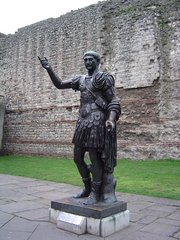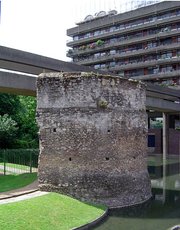London Wall
|
|
 Statue of Trajan in front of a section of the Roman wall, Tower Hill |
London Wall was the defensive wall built by the Romans around Londinium, their strategically important port town on the river Thames in England.
The wall had a number of gates around the outside that led to important Roman roads, leading to other towns in the country. The original list of gates on the wall going clockwise from Ludgate in the east to Aldgate in the west were: Ludgate, Newgate, Aldersgate, Cripplegate, Bishopsgate and Aldgate. Some of the gates, though now long gone, are remembered by the areas or roads where the gates stood being named after them. Due to the rapid growth of the city, the number of gates was increased to cope with the extra traffic in the medieval period, and the walls were also strengthened and built upon.
Today all that remains of the wall are a few (albeit substantial) fragments, some of which can be seen in the grounds of the Museum of London, in the Barbican Estate and around Tower Hill. Part of the route originally taken by the northern wall is commemorated by the road also named London Wall on which the museum is located. The modern road starts in the west with a roundabout with Aldersgate then passes east past Moorgate, and eventually becomes Wormwood Street before it reaches Bishopsgate. One of the largest and most readily accessed fragments of the wall stands just outside Tower Hill tube station, with a replica statue of the Emperor Trajan standing in front of it.
The wall was constructed largely from Kentish ragstone brought by water from Maidstone. It enclosed an area of about 330 acres (1.3 km²), was 6 to 9 feet (2 to 3 m) wide and about 18 feet (5 m) high, with a ditch or fossa in front of the outer wall, measuring some 6 feet (2 m) deep by between 9 to 15 feet (3 to 5 m) wide. It included a number of bastions (at least twenty) spaced about 70 yards (64 m) apart; the best-preserved of these can be seen at the Barbican Estate, next to the church of St Giles-without-Cripplegate. The wall appears to have been built in the late 2nd century and continued to be developed until at least the end of the 4th century, making it among the last major building projects undertaken by the Romans before their withdrawal from Britain in 410.
The wall remained in active use as a fortification for over 1,000 years afterwards. It was used to defend London against raiding Saxons in 457, and was redeveloped in the medieval period with the addition of crenellations, more gates and further bastions. It was not until as late as the 18th and 19th centuries that the wall underwent substantial demolition, though even then large portions of it survived by being incorporated into other structures. Amid the devastation of the Blitz, some of the tallest ruins in the bomb-damaged City were remnants of the Roman wall.
The wall's moat has also left its mark on London; it forms the line of the street of Houndsditch. This was once London's main rubbish disposal site and was notorious for its appalling odour; its name, according to the 16th century historian John Stow, was derived "from that in old time, when the same lay open, much filth (conveyed forth of the City) especially dead dogges were there laid or cast." The moat was finally covered over and filled in at the end of the 16th century, becoming the present street.
See also
- London
- Walbrook
- defensive wall
- fortifications
- London Stone
- List of walls
- Roman Britain
- Roman invasion of Britain
- Roman sites in the United Kingdom
External links
- Map of present day street named 'London Wall' (http://streetmap.co.uk/newmap.srf?x=532608&y=181557&z=1&sv=london+wall&st=6&tl=London+Wall,+London,+EC2v&searchp=newsearch.srf&mapp=newmap.srf)
- http://www.museumoflondon.org.ukhe:חומת לונדון

